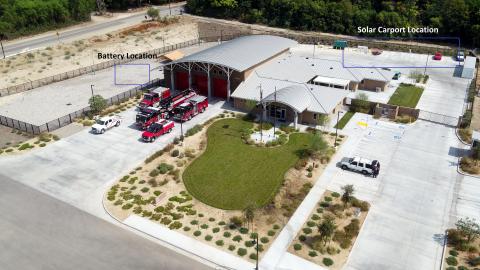The Soboba Fire Station Microgrid project is set to begin this month starting with installation of a concrete platform to host the Vanadium Redox Flow Battery system provided by Invinity Energy Systems. A carport canopy, 59kW solar array, located at the rear parking lot will not only provide shade for team member cars but more importantly will support the solar panels that will be connected to the grid. The project will be providing cost savings to the facility and backup power for emergency operations during power outages
“The project will accommodate future growth, including the installation of EV chargers and the possible integration of a larger microgrid.” Daniel B. Dumovich, Director of Strategic Initiatives at GRID Alternatives, said.
The need for this project is significant. The Soboba Band of Luiseño Indians reservation is located in a Tier 3 Extreme High Fire Threat Zone and has experienced 17 grid outages in the past three years, including 8 in 2019. The average outage duration is seven hours, but some have lasted longer than 24 hours during high wind conditions and public safety power shutoff events. The outages affect both the safety and the quality of life of both tribal members and surrounding communities and conditions could be exacerbated during an emergency such as a natural disaster, resulting in longer outages.
The Soboba Fire Station serves the tribe and surrounding communities with fire and emergency services but it is subject to the same outages as the rest of the community with only a costly, highly polluting diesel generator as backup. The tribe has also expressed an interest in expanding educational opportunities in the clean energy economy that currently do not exist there.
This solar charged, long-duration energy storage and critical resilience project will uniquely solve the issues described above. The system consists of 50 kW/500 kWh of energy storage and 50 kW of solar photovoltaic panels. The daily operations of the system will cut electric bills significantly for the tribe and bring in demand response revenues. During the grid outages described above, the system will provide at least 10 hours of backup service, with the potential to provide 24 or more hours during times of high exposure to the sun’s rays, where the battery storage can recharge from the solar PV.
This potential for long backup power will be especially effective during major emergency events, where the system can convert the Soboba Fire Station into a community emergency center.
An added benefit to the project is that Soboba is recruiting tribal members for job-training opportunities. GRID Alternatives will provide essential workforce development training to prepare tribal members to enter the clean energy economy. These paid job training positions will allow trainees to gain vital hands-on experience and valuable skills related to the project, including solar installation, energy system management, advanced energy storage integration and other topics that will help them advance in their renewable energy related careers.
But the advantages to this project go beyond the Soboba reservation. This project will bolster the technological advancement of renewable energy-charged, long-duration storage and resilience technologies in other tribal communities and in low-income communities. By proving the unique business case for serving a critical emergency facility in a tribal community with this integrated technology, this project will open the door for similar systems to be sited and serve tribal, remote and disadvantaged communities across the state.
Specifically for Soboba, the system will reduce electric bills for the tribe by more than $13,000 annually, with total savings of about $300,000 over the 20-year lifetime of the system. The system will increase overall grid reliability by serving an extreme high fire threat section that experiences frequent outages and PSPS events. The reliability value to the tribe is exceptionally high due to the ability to provide fire and emergency services during an outage.
The fire station will have electricity during emergencies and can serve the surrounding community for at least 10 hours, and more than 24 hours with the inclusion of solar PV, helping to increase public safety. Bringing generation sources closer to the end-use will greatly increase the tribe’s energy security as well.
This system will lower greenhouse gasses (GHGs) by 537,423 kg (1,182,331 lbs) and nitrous oxides (NOx) by 485 kg (1,066 lbs) over 20 years compared to a baseline of no system installed. The public health benefits of this project are the increased services during outages and emergencies, as well as the avoided social cost of carbon and particulate matter from diesel generators.
GRID Alternatives is a nonprofit and national leader in providing access to clean, affordable renewable energy, transportation and jobs to economic and environmental justice communities nationwide. GRID’s workforce development programs provide hands-on training to connect people to clean energy jobs. GRID Alternatives’ National Tribal Program has worked since 2010 to help Tribal communities across the United States achieve their renewable energy goals. GRID maintains a long-term, strong and trusting working relationship with the Tribal communities selected for this project.
For more information, https://gridalternatives.org/.
Photos courtesy of GRID Alternatives



